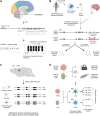Isoform Age - Splice Isoform Profiling Using Long-Read Technologies
- PMID: 34409069
- PMCID: PMC8364947
- DOI: 10.3389/fmolb.2021.711733
Isoform Age - Splice Isoform Profiling Using Long-Read Technologies
Erratum in
-
Corrigendum: Isoform Age - Splice Isoform Profiling Using Long-Read Technologies.Front Mol Biosci. 2021 Sep 27;8:767743. doi: 10.3389/fmolb.2021.767743. eCollection 2021. Front Mol Biosci. 2021. PMID: 34646863 Free PMC article.
Abstract
Alternative splicing (AS) of RNA is a key mechanism that results in the expression of multiple transcript isoforms from single genes and leads to an increase in the complexity of both the transcriptome and proteome. Regulation of AS is critical for the correct functioning of many biological pathways, while disruption of AS can be directly pathogenic in diseases such as cancer or cause risk for complex disorders. Current short-read sequencing technologies achieve high read depth but are limited in their ability to resolve complex isoforms. In this review we examine how long-read sequencing (LRS) technologies can address this challenge by covering the entire RNA sequence in a single read and thereby distinguish isoform changes that could impact RNA regulation or protein function. Coupling LRS with technologies such as single cell sequencing, targeted sequencing and spatial transcriptomics is producing a rapidly expanding suite of technological approaches to profile alternative splicing at the isoform level with unprecedented detail. In addition, integrating LRS with genotype now allows the impact of genetic variation on isoform expression to be determined. Recent results demonstrate the potential of these techniques to elucidate the landscape of splicing, including in tissues such as the brain where AS is particularly prevalent. Finally, we also discuss how AS can impact protein function, potentially leading to novel therapeutic targets for a range of diseases.
Keywords: Oxford Nanopore Technologies nanopore sequencing; PacBio; alternative splicing; isoform; long-read sequencing; single cell sequencing; spatial transcriptomics; targeted RNA sequencing.
Copyright © 2021 De Paoli-Iseppi, Gleeson and Clark.
Conflict of interest statement
RP, JG and MC have received support from ONT to present their findings at scientific conferences. ONT played no role in study design, execution, or publication.
Figures



Similar articles
-
Developmental isoform diversity in the human neocortex informs neuropsychiatric risk mechanisms.bioRxiv [Preprint]. 2023 Oct 11:2023.03.25.534016. doi: 10.1101/2023.03.25.534016. bioRxiv. 2023. Update in: Science. 2024 May 24;384(6698):eadh7688. doi: 10.1126/science.adh7688. PMID: 36993726 Free PMC article. Updated. Preprint.
-
Corrigendum: Isoform Age - Splice Isoform Profiling Using Long-Read Technologies.Front Mol Biosci. 2021 Sep 27;8:767743. doi: 10.3389/fmolb.2021.767743. eCollection 2021. Front Mol Biosci. 2021. PMID: 34646863 Free PMC article.
-
Transcript Profiling Using Long-Read Sequencing Technologies.Methods Mol Biol. 2018;1783:121-147. doi: 10.1007/978-1-4939-7834-2_6. Methods Mol Biol. 2018. PMID: 29767360
-
Methodologies for Transcript Profiling Using Long-Read Technologies.Front Genet. 2020 Jul 7;11:606. doi: 10.3389/fgene.2020.00606. eCollection 2020. Front Genet. 2020. PMID: 32733532 Free PMC article. Review.
-
Enhancing novel isoform discovery: leveraging nanopore long-read sequencing and machine learning approaches.Brief Funct Genomics. 2024 Dec 6;23(6):683-694. doi: 10.1093/bfgp/elae031. Brief Funct Genomics. 2024. PMID: 39158328 Review.
Cited by
-
RNA Transcript Diversity in Neuromuscular Research.J Neuromuscul Dis. 2023;10(4):473-482. doi: 10.3233/JND-221601. J Neuromuscul Dis. 2023. PMID: 37182892 Free PMC article. Review.
-
Relevance and Regulation of Alternative Splicing in Plant Heat Stress Response: Current Understanding and Future Directions.Front Plant Sci. 2022 Jun 23;13:911277. doi: 10.3389/fpls.2022.911277. eCollection 2022. Front Plant Sci. 2022. PMID: 35812973 Free PMC article. Review.
-
Associations between DNA methylation and gene regulation depend on chromatin accessibility during transgenerational plasticity.BMC Biol. 2023 Jun 26;21(1):149. doi: 10.1186/s12915-023-01645-8. BMC Biol. 2023. PMID: 37365578 Free PMC article.
-
Identification of cell barcodes from long-read single-cell RNA-seq with BLAZE.Genome Biol. 2023 Apr 6;24(1):66. doi: 10.1186/s13059-023-02907-y. Genome Biol. 2023. PMID: 37024980 Free PMC article.
-
Direct RNA sequencing of astronaut blood reveals spaceflight-associated m6A increases and hematopoietic transcriptional responses.Nat Commun. 2024 Jun 11;15(1):4950. doi: 10.1038/s41467-024-48929-3. Nat Commun. 2024. PMID: 38862496 Free PMC article.
References
Publication types
LinkOut - more resources
Full Text Sources
Other Literature Sources
Research Materials

